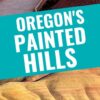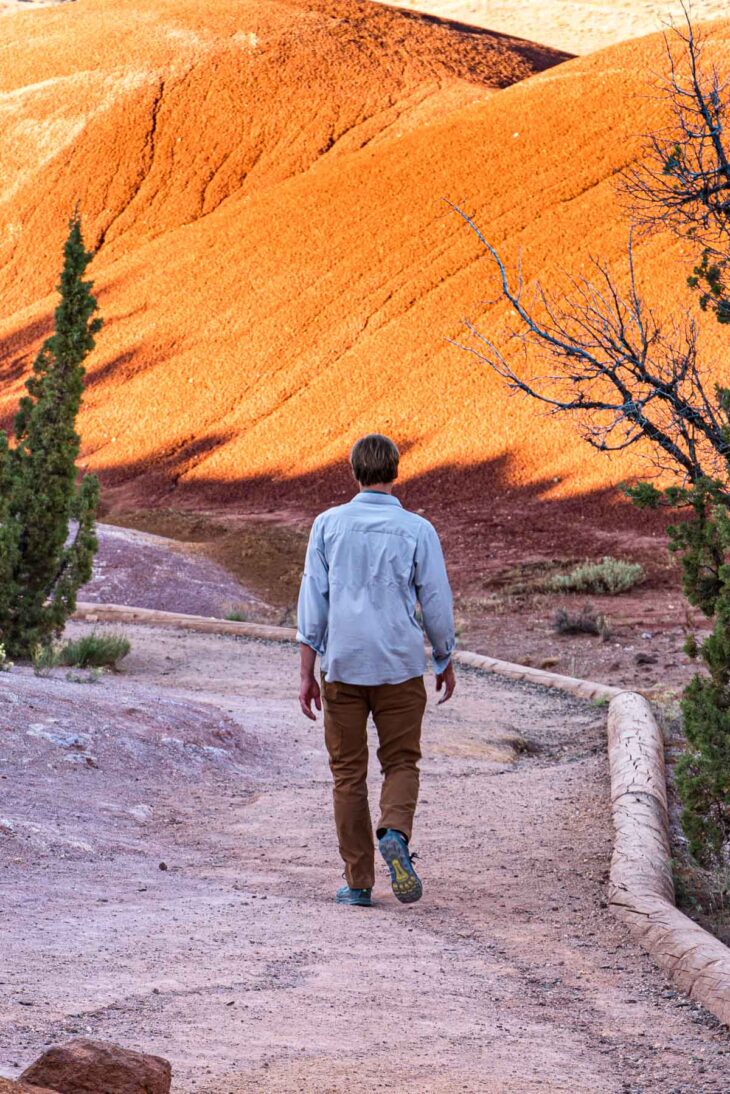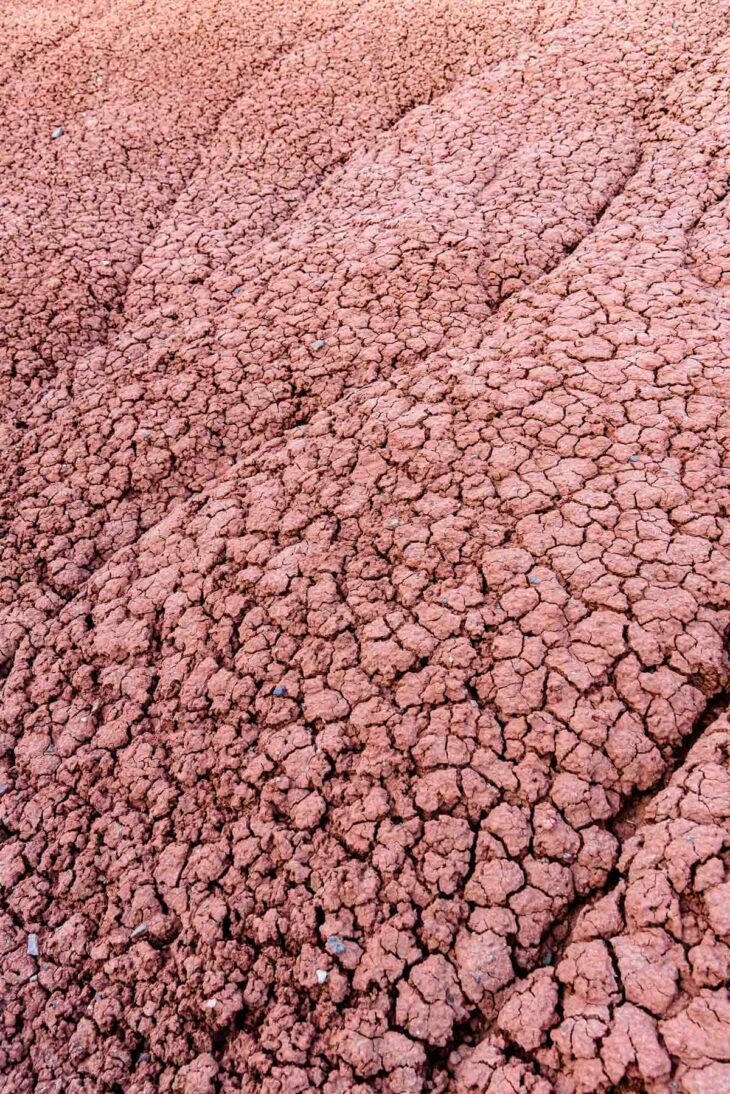Explore the Painted Hills, Oregon
This post may contain affiliate links.
Layered shades of reds, yellow, orange, purple, green, and black… do you think we’re describing something in an art museum, or a spectacular outdoor landscape?! The Painted Hills in Oregon are an out-of-this-world geological formation and in this guide, we’re sharing all our best tips and things to do when you visit.
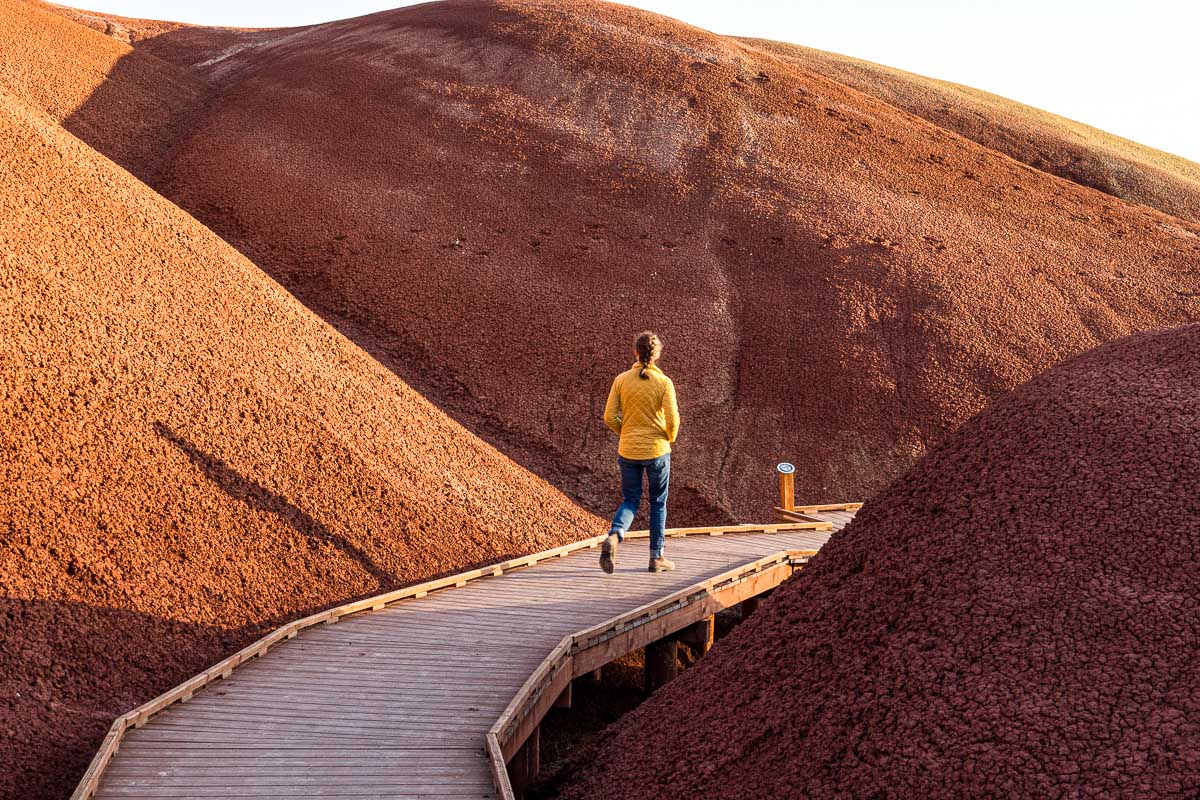
The Painted Hills are unlike anything we’ve seen before. Like a geological rainbow, the hills are stratified with distinct layers of red, orange, yellow, and purple that slowly change hue as the light shifts throughout the day. As the sun starts to set and the contrast of the shadows increases, the changing values look like the landscape is being color edited in real life. For us, the experience was mesmerizing.
If you are interested in incredible and otherworldly landscapes and volcanic geology, then you should definitely consider a trip out to the Painted Hills!
In this post you’ll find everything you need to know about visiting Oregon’s Painted Hills including what to do, tips for visiting, where to stay, and other things to see in the area.
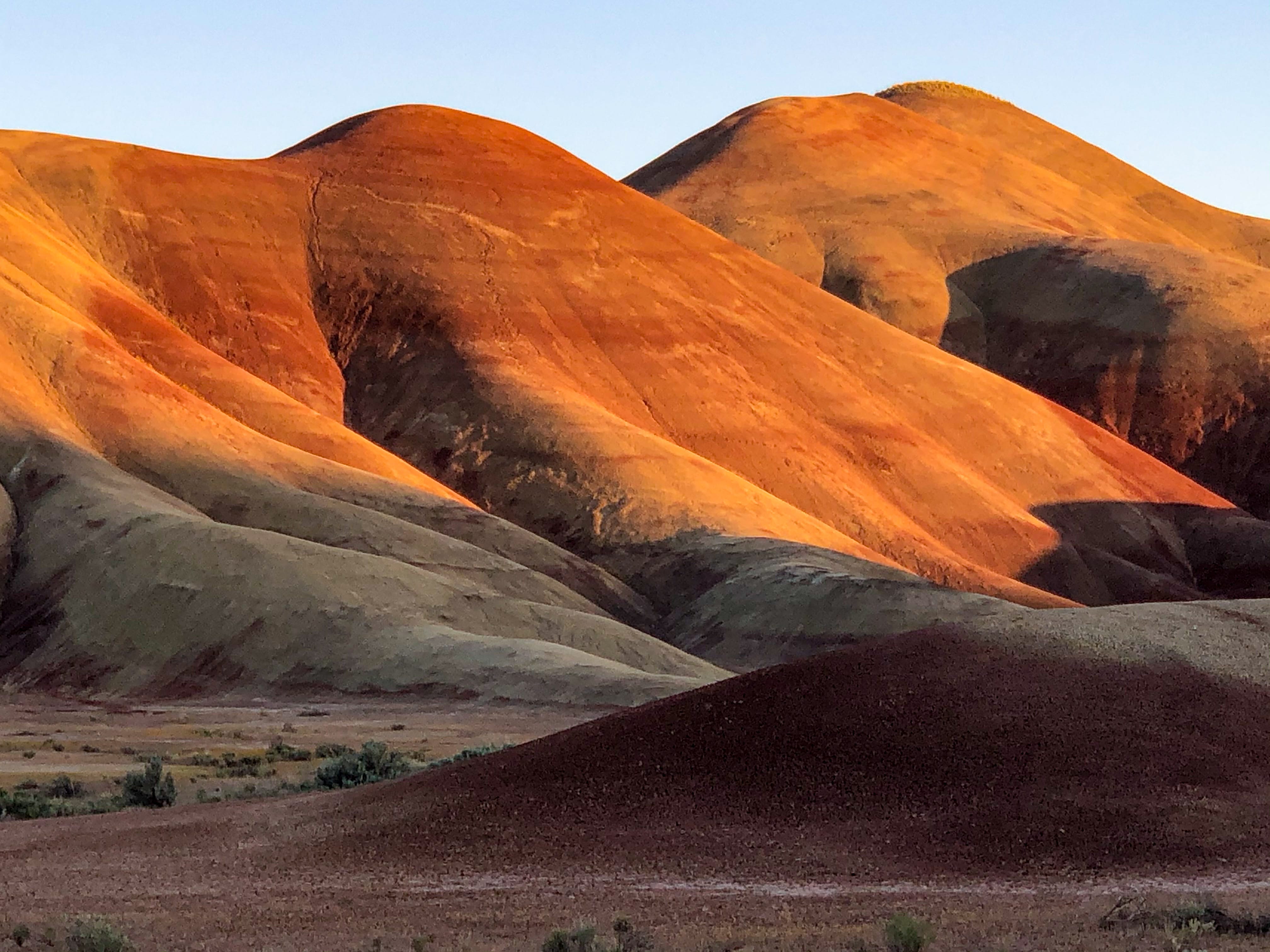
Are the Painted Hills Worth Visiting?
One question the internet seems to have is Are the Painted Hills worth it? Here’s our honest answer… Should you book a flight out to Oregon *just* to see the Painted Hills? …Probably not. The park is small and will probably only warrant a half day visit (or a full day to explore the surrounding area).
But, if you’re looking to do a day trip from Bend, a weekend getaway from Portland, or are planning an Oregon road trip, then this is absolutely a stop you should add to your itinerary!
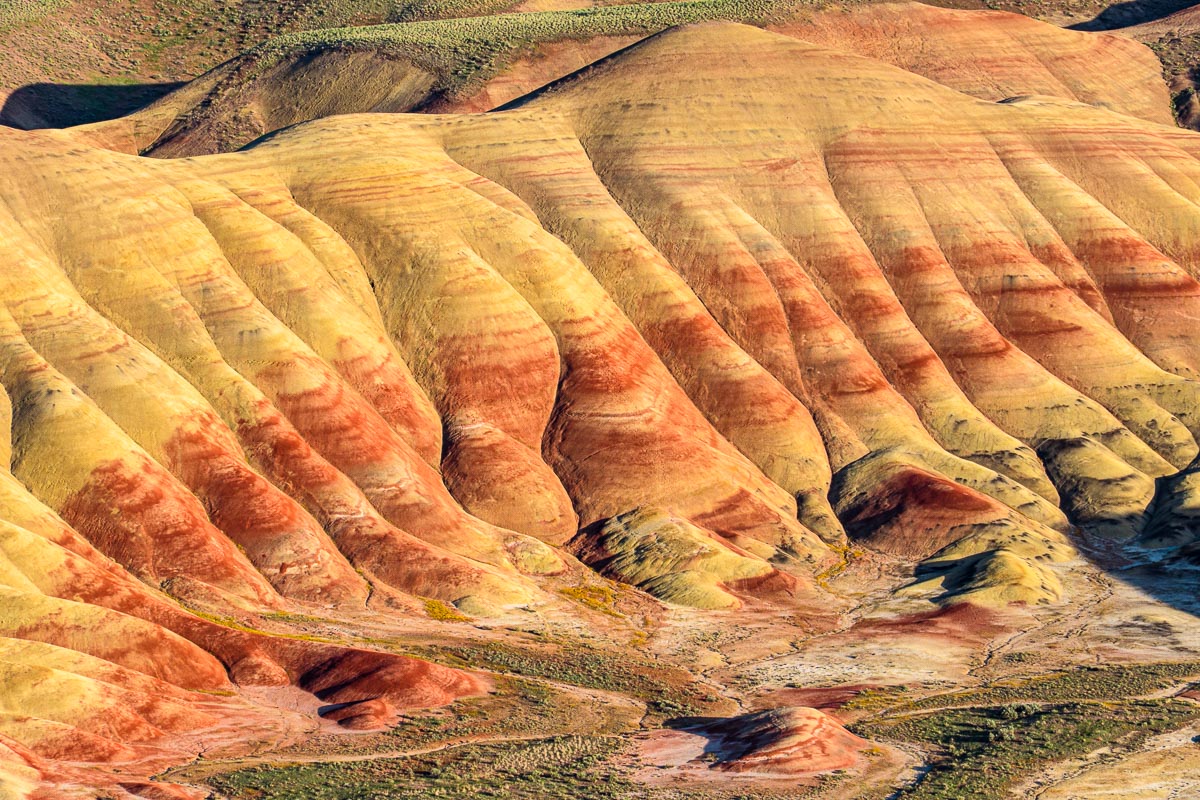
What gives the Painted Hills their color?
Formed 35 million years ago, the Painted Hills are a fascinating display of how climate can affect geology.
The hills were formed during a series of volcanic eruptions in the Cascades to the west in which volcanic ash drifted east and settled in a floodplain basin.
The red and yellow stripes in the hills are formed by minerals that were present in the ash and laterite floodplain soils—specifically iron and aluminum.
The reds were formed during warm, humid climates and the yellows during drier, cooler climates.
During the time that the Painted Hills were formed, there were distinct wet and dry periods resulting in the banded, layered colors.
The black soil that streaks though the hills was formed from vegetation that grew in the floodplain, and gray colors come from shale, siltstone, and mudstone.
What to do at the Painted Hills
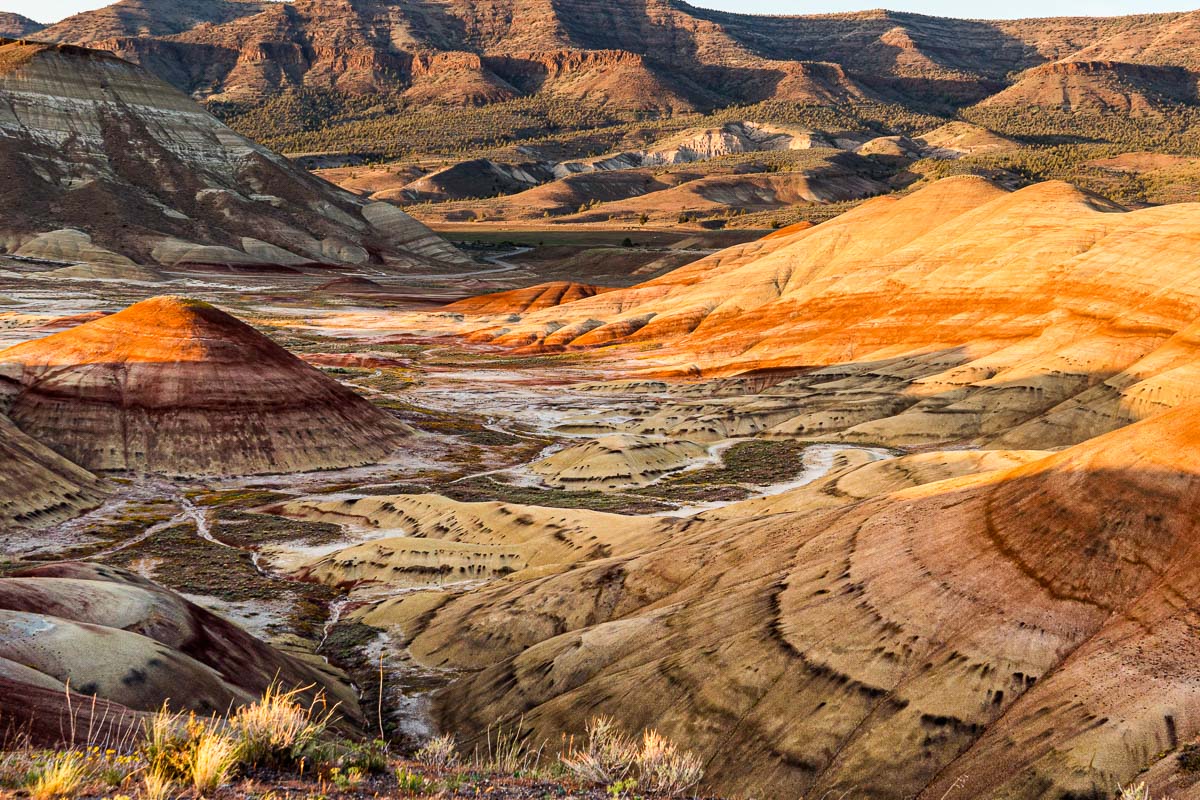
Explore the Painted Hills Overlook
The Painted Hills Overlook is a great place to start your exploration of the park. Here you can walk up a wide path that will allow you to see the hills from various vantage points. Bring a pair of binoculars if you’d like to get a closer look at the textures—this trail doesn’t take you through the hills (check out Painted Cove trail or Red Hill trail instead) but it does give you a wide view to take it all in!
Trail rating: Easy | ⅔ mile out & back (78 ft elevation gain)
See the trail notes & map here.
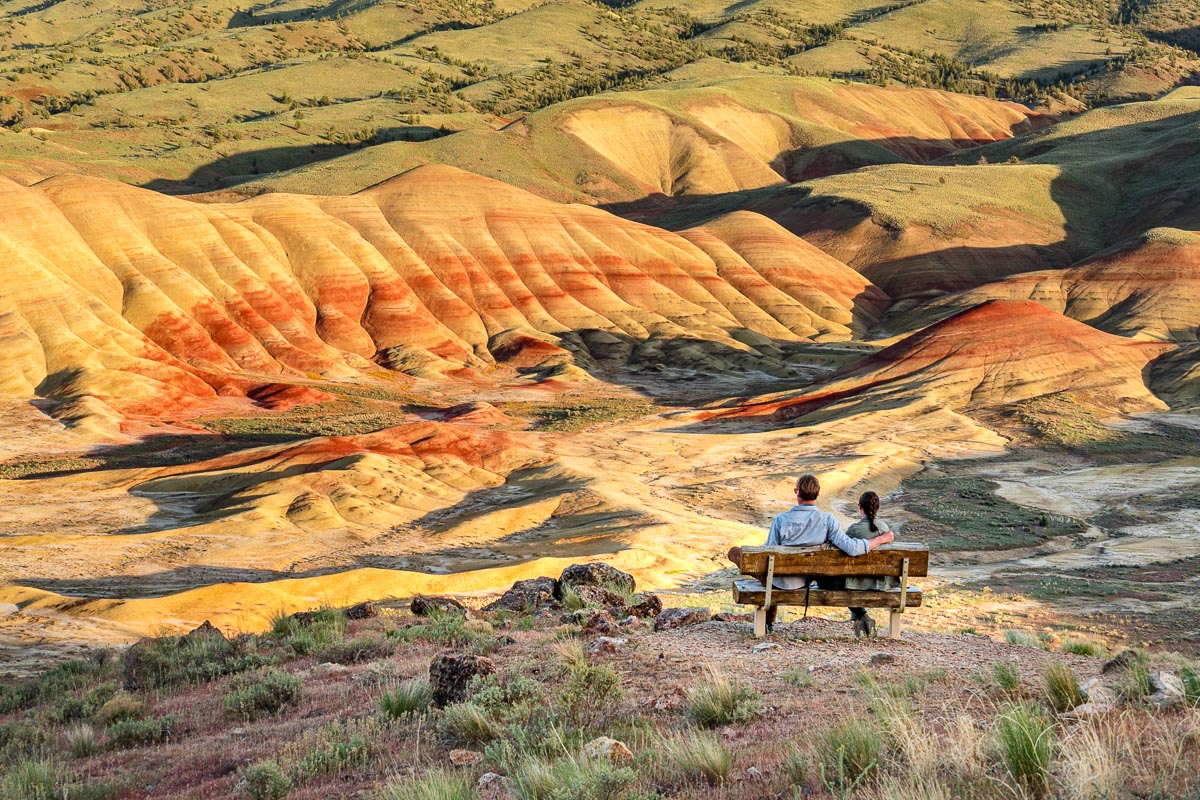
Hike the Carroll Rim Trail
The Carroll Rim Trail is the only hike with significant elevation gain, making it more challenging than the other paths in the park (though fairly easy if you take your time and enjoy the benches along the trail), but it also gives you a full view of the basin where the Painted Hills are located.
Trail rating: Easy-moderate | 1 ½ miles out & back (374 ft elevation gain)
See the trail notes & map here.
Wander along the Painted Cove Trail
The Painted Cove Trail has become one of the most iconic locations in the park. Have you seen the photos of the wooden boardwalk winding through what looks like a martian landscape? This is the spot! This trail will take you between a number of hills where you will be able to see the textures and color variations up close. It’s a short walk, so take your time and enjoy the details!
Trail rating: Easy | ⅓ mile loop
Get the trail notes & map here.
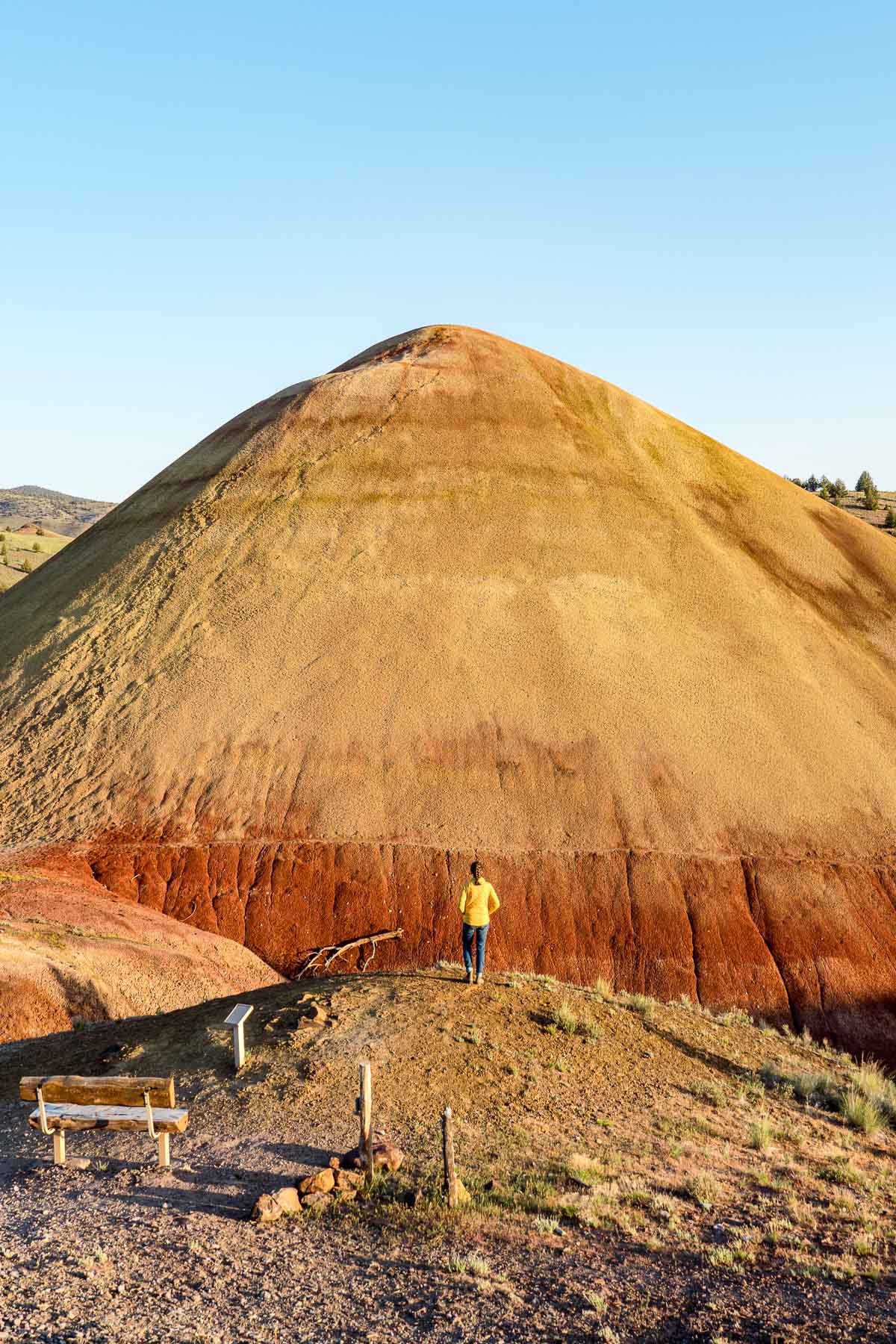
Walk around the Red Hill (Red Scar Knoll)
This path brings you around a singular, two toned hill—the front side is vivid red and the back side is yellow. Like Painted Cove, this trail brings you pretty close to the hill so you’re able to see it right up close.
Trail rating: Easy | ½ miles out and back
Get the trail notes & map here.
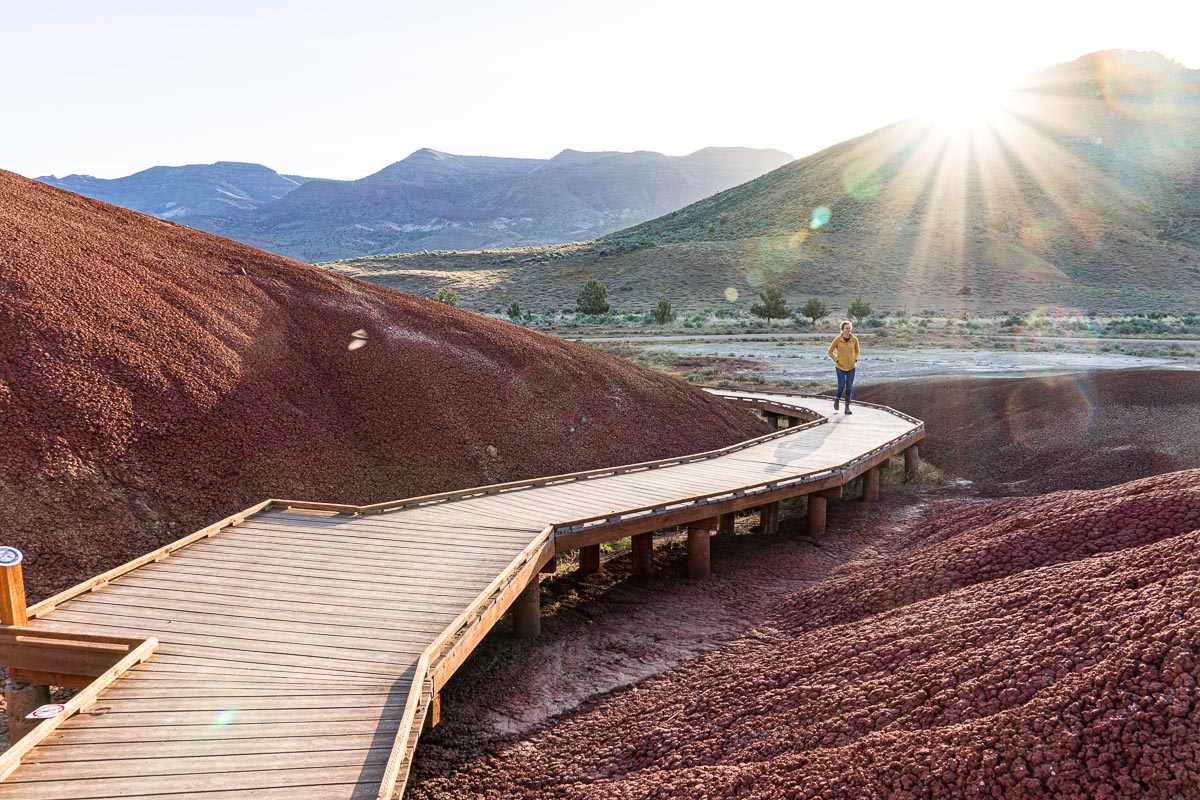
Photography
The diverse colors and textures of the Painted Hills make them a photographer’s dream!
As the hills are mostly west-facing, the best time of day is in the evening golden hour. Although some spots light up during sunrise as well.
We found these to be the top three photography spots in the park:
- Painted Cove Trail: a popular photo spot with an iconic boardwalk snaking through the bright red hills
- Painted Hills Overlook: Sunset is a great time to capture the vivid colors and the long shadows add drama and depth to the hills
- Carroll Rim Trail: This trail gives you a panoramic view of the hills and is a great sunset spot—perfect if you have a telephoto lens
Stargazing
Located far outside of any large city, the Painted Hills are free of light pollution making them an excellent location for stargazing. The Milky Way is visible in Oregon from late March through early October.
Biking
If cycling or bikepacking is your jam, you’ll be excited to learn that the Painted Hills are part of the Painted Hills Scenic Bikeway, a 161 mile cycling route that connects all three units of the John Day Fossil Beds National Monument. The bikeway is designed as a hub and spoke so you can pick from multiple segments depending on how long of a ride you are interested in.
If you’re into gravel riding, a shorter, 42 mile mixed gravel/paved loop around the Sutton Mountain Wilderness Area can be found here—perfect for a one or two day ride.
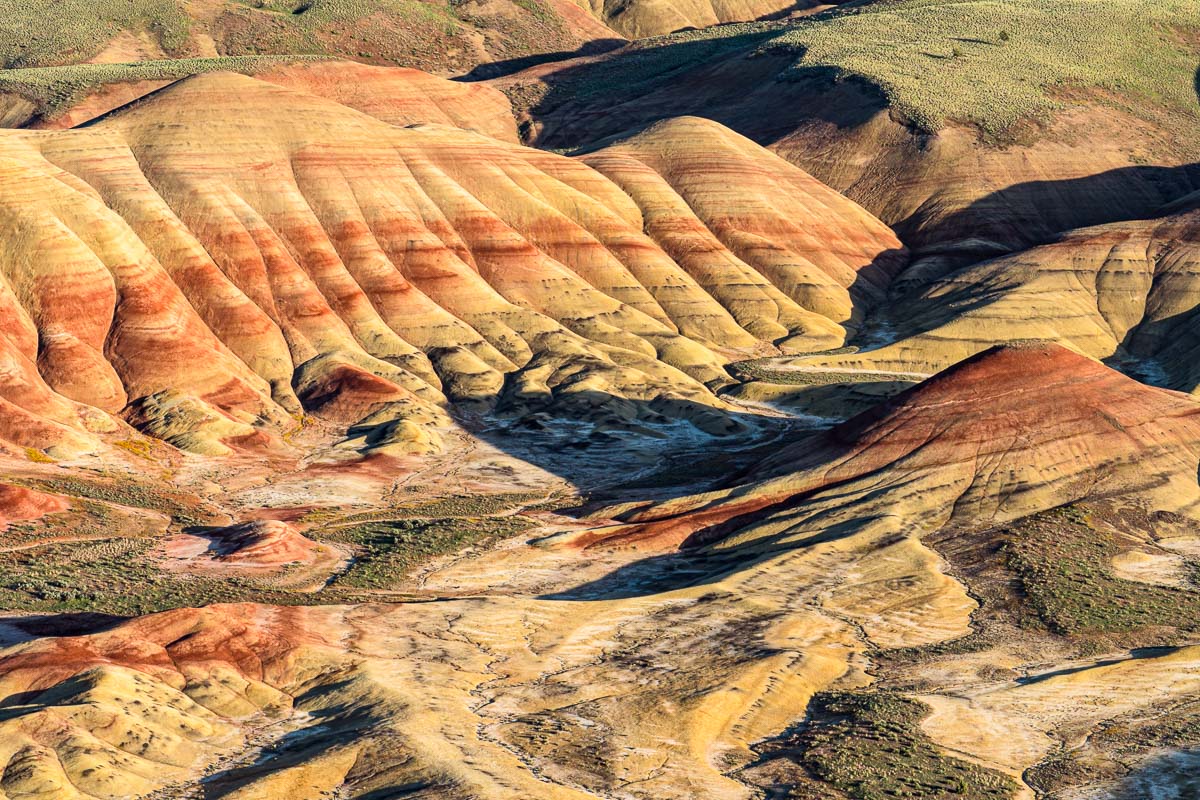
Need to know tips for visiting the Painted Hills in Oregon
- Once you turn into the park, the road turns to gravel. You don’t need to have a high clearance 4×4 vehicle to drive it, but do take it slow and be aware that snow and heavy rain can affect it.
- Come prepared with refillable water bottles. The only place to fill up on water is at the picnic area near the entrance of the park. The water fountain is turned off during the winter months.
- Bathrooms, a water fountain, and picnic tables are available near the entrance of the park, but there are no facilities once you drive further in.
- There is little shade to be found along the trails in the Painted Hills, so be sure to stay hydrated and wear sunscreen, a hat, and sun-protective clothing.
- Please stay on the trails at all times! The hills and surrounding soils are extremely fragile and going off trail can do irreparable damage. It is painfully obvious where some people have walked off path and ruined the delicate soil for everyone—please don’t be that person!
- Leave what you find. This area has been studied for decades by paleontologists for good reason—the area is full of fossilized plants and animals! If you come across any fossils, let them be (in addition to Leave No Trace, they are federally protected).
- Dogs are allowed on trails and at the park’s overlooks, but must be kept on leash at all times.
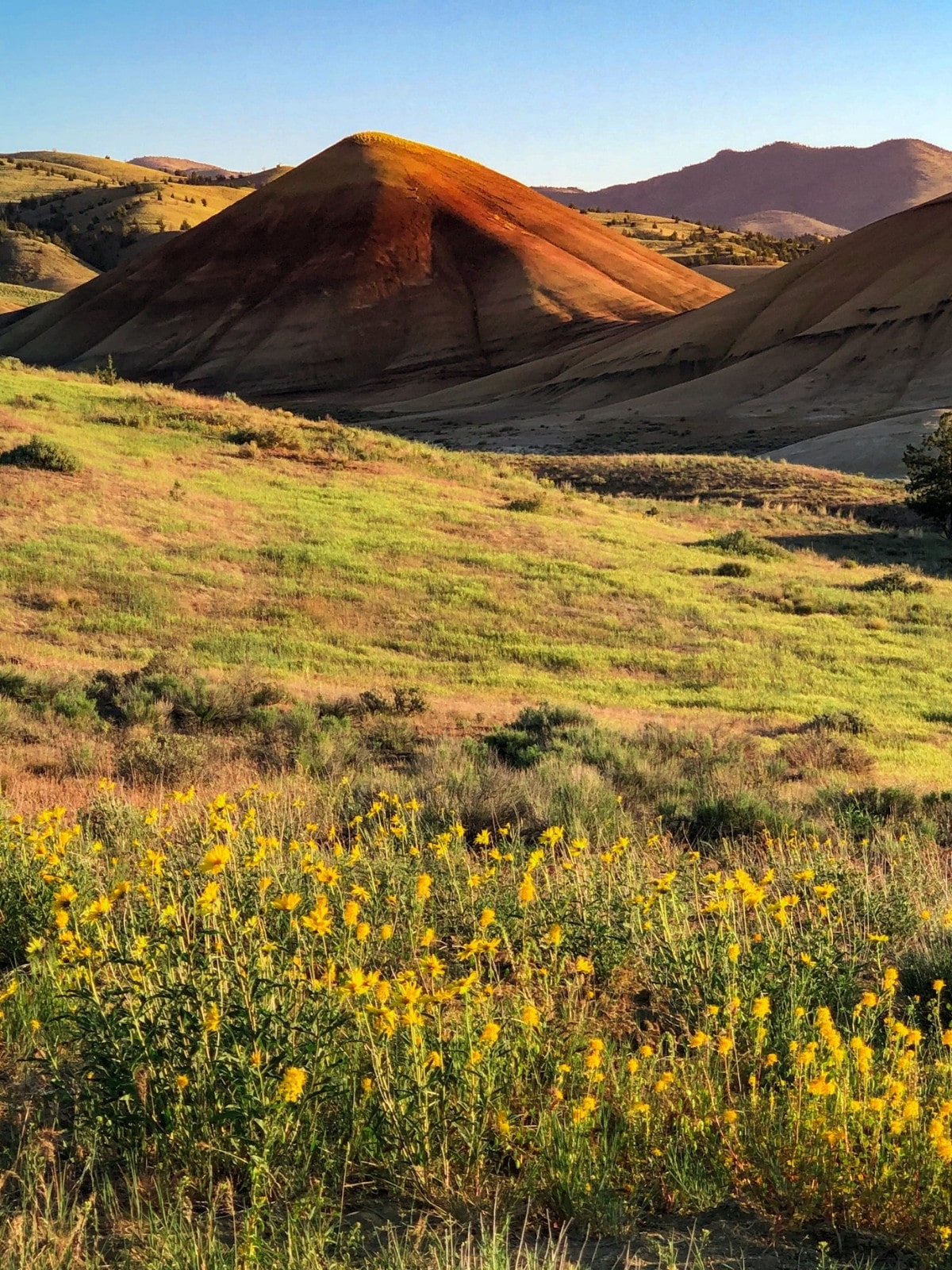
What is the best time to visit Painted Hills Oregon?
The Painted Hills are open year-round, but the best times to visit are in the spring and the fall which is when you’ll find pleasant temperatures.
In the summer, the daytime temperatures can easily climb into the 90’s and beyond and nearly all areas in the park are exposed & unshaded.
In the winter, the limited facilities are closed and winter weather can affect the driveability of the gravel road going into the park.
April and May will give you the best opportunity to see wildflower blooms. Although you’re more likely to encounter rain during these months, it’s said that the colors in the hills are at their best right after the rain!
Fall will bring cooler temperatures and less chance of rain.
How to get there
The Painted Hills are located 10 miles northwest of the town of Mitchell, OR. The best way to get driving directions is to put “Painted Hills Overlook” into Google Maps. Be sure to set your directions before you leave—there is spotty service in this part of the state.
- From Portland: 225 miles (4 ½ hours) via Journey Through Time Scenic Byway
- From Bend: 86 miles (2 hours) via Hwy 26
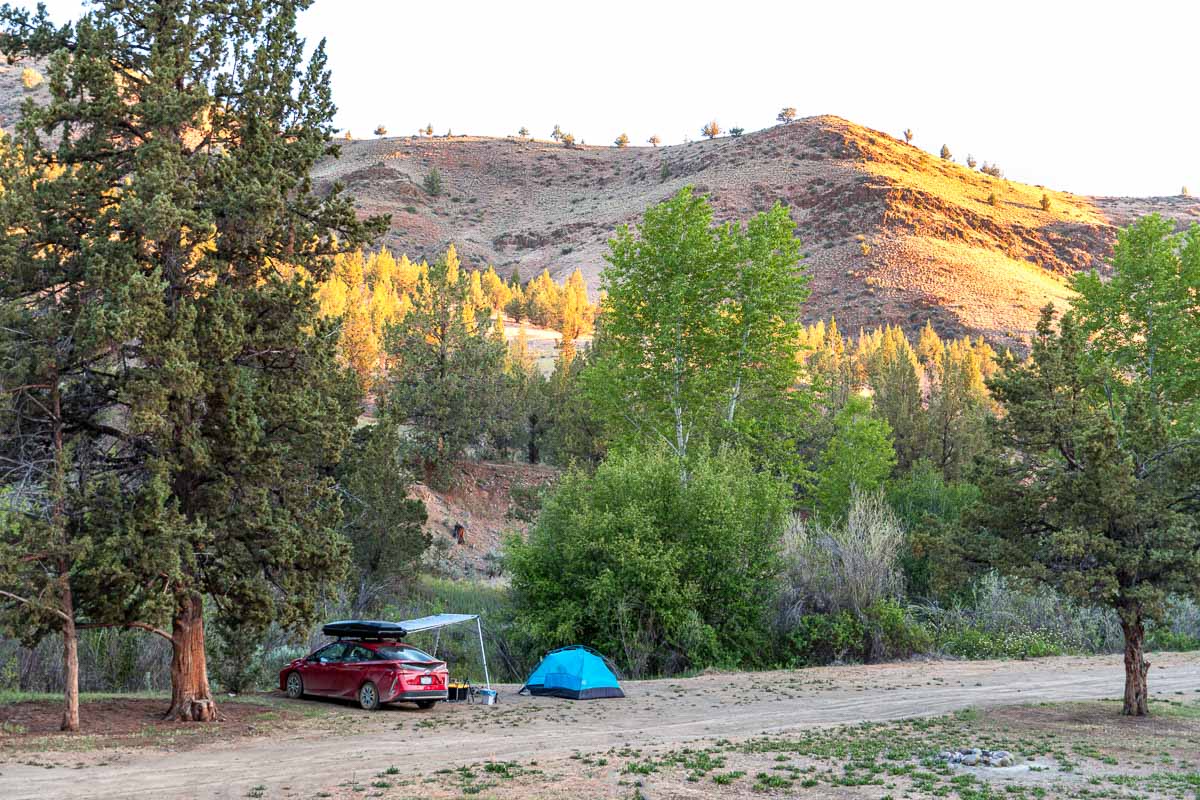
Where to stay near the Painted Hills
The Painted Hills are in a fairly remote location, so accommodations are limited. In the nearby town of Mitchell, you can find a handful of AirBnB’s (see listings) as well as a hostel (Spoken Hostel).
Camping near Painted Hills
There are a number of free camping areas on BLM land near the Painted Hills. These are dispersed and/or primitive sites, not your typical campgrounds, so be prepared with everything you need. You can read more about what to expect and pack when free camping here. Note that there are seasonal fire bans in this area and you will need to use liquid gas/propane stoves between June 1-September 30.
Bridge Creek Dispersed Camping
This dispersed camping site is 5 miles from the entrance of the Painted Hills. There are a number of spots to set up camp. There are no facilities so you will need to be completely self-sufficient, but this makes for a great base camp to easily access the park for sunrise or sunset. This is where we camped when we visited the area!
Find it here on Google Maps
Priest Hole Recreation Site
Located 8 miles beyond the Painted Hills down an unpaved road, this primitive site sits right along the John Day River where you can swim, float, and fish. There is one pit toilet but no other amenities like trash or potable water — bring a water filter to treat water from the river, or pack in all the water you will need.
Find it here on Google Maps
Where to eat in Mitchell, OR
- Tiger Town Brewery: Indoor & outdoor dining with good lunch and dinner options (get the Greek Nachos if they are on the menu!). Check their events page to see if there is any live music planned during your visit.
- Bridge Creek Cafe: American diner breakfast & burgers
- Route 26 Espresso: Classic PNW drive-up coffee cart located just west of Mitchell on Hwy 26.
Other things nearby Oregon’s Painted Hills
- John Day Fossil Beds Monument: There are two additional units that make up the national monument which you can explore.
- Sheep Rock Unit: An hour east of the painted hills on Hwy 26 you’ll find the Sheep Rock Unit, where you will find the Thomas Condon Paleontology Center and a number of trails and overlooks to explore, including Blue Basin.
- Clarno Unit: If you’re coming from Portland, the Clarno unit is 18 miles from the town of Fossil. This unit is known for the Trail of Fossils where you can see fossils in the rocks. It’s about two hours from the Painted Hills so it’s likely not worth the detour unless you’re already approaching the park from the north.
- John Day River & Priest Hole Recreation Site: Located 7 miles past the Painted Hills via an unpaved road, you’ll find Priest Hole Recreation Site along the John Day River. In addition to camping, this is a great spot to enjoy the river with a swim or to spend some time fly fishing (a license is required). More info: Priest Hole Recreation Map & Brochure
- Walton Lake: About halfway between Prineville and Mitchell is Walton Lake, a pretty spot with a campground where you can swim, paddle, canoe, and fish.

